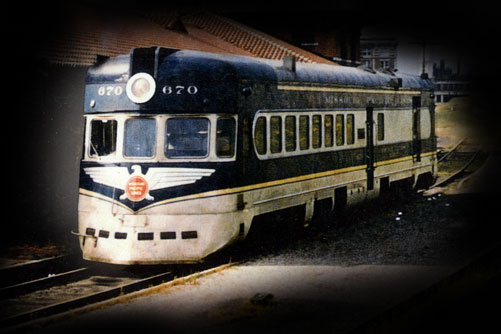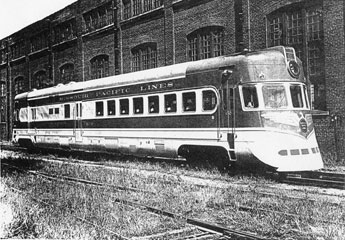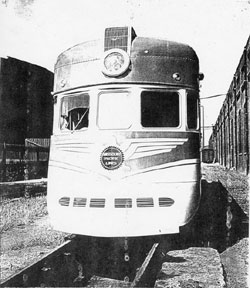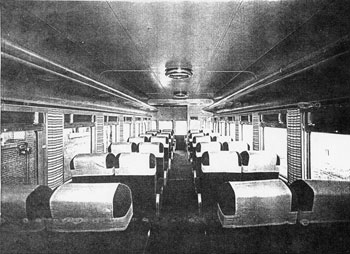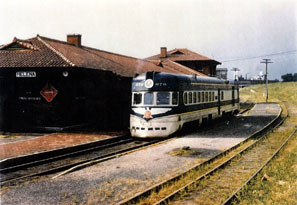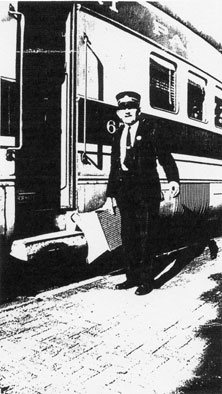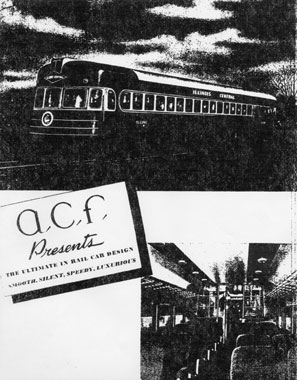This website has been archived from TrainWeb.org/screamingeagle to TrainWeb.US/screamingeagle.
|
|||||
| HOME Power Cabooses Rolling Stock MoW Depots | |||||
click thumbnails for larger image![]()
D.
H. Andrews and
Young Richard Travel was much less formal on the Eaglette than her parent Eagle streamliners, as testified by Richard Andrews. A member of the Missouri Pacific Historical Society, he has the MoPac in his blood. Now retired, Richard was born in 1937 as one of seven children growing up in Lincoln, Nebraska. His father, David H. Andrews spent his entire 40+ career on the MoPac's Omaha division, including as brakeman for Lincoln's ten-wheeler steam trains and later for the Eaglette Motorailer. Brakeman David is pictured on the back cover of Michael Bartels' book "Missouri Pacific River & Prairie Rails", sitting on the cow catcher, as well as other images on pages 106 & 116. A glimpse of the railroad's wartime service as witnessed by a very young Richard is also retold on page 119 of the same book. Richard recalls that he and his brothers often would accompany their father as he worked as brakeman on the Eaglette. During these trips in the early 1940's many, many trains out of Lincoln were packed with 100's of troops on their way to fight in the "War to End All Wars". And, on a more sobering note, Richard sadly notes the return trips would carry the remains of too many young men back to Lincoln in wooden boxes on their way to Umber's Mortuary. From Union the Eaglette was sometimes packed to the doors after the Missouri River Eagle left off her travelers, bound for Lincoln. With gas and tire rationing, rail travel was the once again the prefered way to travel across the country. Though she was designed to seat 34, passengers, temporary bench seating was added along the baggage compartment walls of the motorailer. Everyone else had to stand for the entire 30+ miles of bounding rail travel back to Lincoln. Despite the wartime inconvieniences, it was often a happy occasion. On one occasion the elder Andrews had to unexpectedly contend with some 100 passengers, in which Richard remembers being sat on a Army WAC's lap, who promised to look after him. By mid-1944, such crowding became so severe that a dozen passengers had to be left at Falls City. Even the Eagles didn't have enough room for any more. A year later however, travel conditions began to notably improve. |
 |
Passenger service in Lincoln, 1939-1940, before the arrival of the #670. The last car on this train was a sleeper which would be switched at Union, Nebraska for St. Louis, Missouri. The power is a pinstripped NW4, one of only two built for the MoPac in 1938. The numberboard is fuzzy, but this engine is still numbered 824, its EMC numbering before becoming MP #4103. The station's spire juts upward in the background as the train prepares to depart on one of its two round trips to Union and back. Photo taken on an old Kodak box camera. - H. Andrews Photo / Richard Andrews Collection |
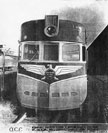 |
#670 Builders shot at St. Charles, Missouri; August 1942, prior to its delivery to Lincoln. - A.C.F. Photo / Richard Andrews Collection |
 |
#670 Builders shot at St. Charles, Missouri; August 1942 - A.C.F. Photo / Richard Andrews Collection |
 |
#670 Builders shot at St. Charles, Missouri; August 1942 - A.C.F. Photo / Richard Andrews Collection |
 |
#670 Builders shot at St. Charles, Missouri; August 1942 - A.C.F. Photo / Richard Andrews Collection |
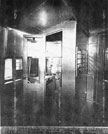 |
Builders shot, view of engineer's cab from the baggage area, at St. Charles, Missouri; August 1942. Mr. Andrews notes that seats were added in the baggage for 6 feet, and folded up and down. Two poles in the floor held the seat up. In addition to the seats, wooden benches had leather covers and backs. - A.C.F. Photo / Richard Andrews Collection |
|
A
little Background on the AC&F MotoRailer
Being much more than a "doodlebug," the self-propelled rail car, called a MotoRailer, were a big change from the noisy, smoky, brutish-looking gas-electric cars that many passengers were familiar with. The American Car & Foundry MotoRailers incorporated the latest in streamlining, had comfortable, visually attractive and air conditioned interiors and were propelled with low compression, electrical ignition diesel power with smooth shifting, torque-converter transmissions. They were also bidirectional with a cab at each end. Information is spotty on these cars, but I've found them to also be used on the PC&SW (4 units built in 1938), the O&W (# 805), the Susquehanna (#1001-1002), and on the Missouri & No Arkansas. In 1947 the New York, Susquehanna and Western bought 2 ACF Motorailer's #1005 and 1006, which were sold back to ACF from the Illinois Central in 1943 and sat at the ACF Berwick plant for 4 years before the NYSW bought them. The Alaska Railroad ran a Navy owned Motorailer #213. Most have met their ultimate fate at the scrappers, but there are still
a few who escaped time. Motorailer #157 (listed as ex Norfolk Southern)
is stored in Cuba of all places. And reportedly you can ride modified
ACF Motorailer cars, powered by n.g. Baldwins, on Colombia's remaining
steam-powered passenger routes in the mountainous Bogota area.
There were also a small number of units of similar construction as the Motorailer that are not listed here. |
 |
The Illinois Central's #130 "Illini" was another example of the few A.C.F. MotoRailers built. Unlike the MoPac's Eaglette, the Illini was mated with a twin, the #131 "Miss Lou" - thus both were not of the bi-directional design. The IC also purchased a two-car MotoRailer which was dubbed "Land O' Corn". Only the forward car had an engineers cab. Photo circa approx. 1940 - Richard Andrews Collection |
 |
Illustration of Waukesha-Hessler 225HP motor. In the original construction of the Eaglette, main power was provided by a pair of 210HP Waukesha-Hesselman engines. According to J. S. Mueller, Waukesha Engine Division, there were three or four different four cylinder engines used in the motorailer application. - Waukesha E. D. Illust. / Richard Andrews Collection |
 |
The MotoRailer power trucks had coil springs over the Timken roller bearing journal boxes with bolster supported on eiliptic springs. The geared axle drive with its shifting mechanism is seen in the foreground. - A.C.F. Photo / Richard Andrews Collection |
|
|
Sources: Every effort has been made to get the correct information on these pages, but mistakes do happen. Reporting of any inaccuracies would be appreciated. |
| All images & text © 2000-2008 T. Greuter / Screaming Eagles, unless otherwise noted. All Rights Reserved. | |











